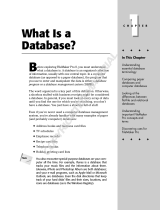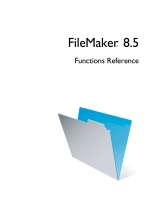Page is loading ...

Customizing your
FileMaker Pro templates
FileMaker
®
Pro software provides a collection of Business, Home, and Education templates to help
you begin using the product. These data-ready templates let you track and manage people, assets,
and products quickly and easily, even if you've never used a database before. The database
templates are beautifully designed, functional, relatively simple, and best of all, can be easily
modified to suit your needs. This document gives you an overview of the FileMaker Pro template
design elements and how you can modify them.
In some cases, customizing means making small changes to the file, such as adding a field or
changing the name of a field. You may also want to create a new file by duplicating a template and
making substantial changes. Both approaches are touched on here.
Let’s start with a look at a typical template layout. Each layout element is labeled with a number.
We’ll go over what each element does.
1.
Name of the file.
2. Buttons.
3.
The most important fields in the record, enlarged for emphasis.
4.
Fields important enough to occur on every layout, above the tabs.
5. Tabs (buttons) that switch to other similar layouts.
6.
Fields specific to each tab.
7.
A calculated field, which doesn’t allow the user to type into it.

2 Customizing your FileMaker Pro templates
1.
In the upper-left corner is the name of the type of items stored in the databases. This is the
equivalent of the table name in some other databases. It is usually a plural noun, such as Companies
or Employees, because the many records in a database file store information about a set of similar
items. The same name may be used for the FileMaker Pro file itself. Repeating it here on the layout
is a good idea, since it serves as an orientation point for the person who will use the file.
Suggestion: Copy an entire template and use it for a similar task. For instance, a salesperson could
use the Purchase Orders file as a Quotes file. Remove or rename the fields you won’t need.
2.
Also in the header part of the templates, scripts have been created for you to use or modify. The
script names that appear in the upper-right corner are text buttons separated by a pipe character (|).
Script names usually begin with a verb such as “Show” or “List,” as in “Show Aging Report” or
“List Overdue Invoices.” The pipe character is an accepted convention in web design, and has less
of a visual impact than three-dimensional buttons, such as the icon buttons at the left. The other
scripted buttons in the header are provided for more frequent tasks such as adding or finding
records.
Suggestion: Use ScriptMaker
™
to add your own script in the tinted bar, next to any other script
names that are there. In Layout mode, copy one of the existing text buttons, and position the new
button precisely so that it lines up on each layout. Use the T-squares to help with alignment.
3.
The most important identifying data are highlighted at the top of the layout using merge fields.
For example, in an Employees file, the employee’s name would appear in this location. These data
will also be displayed in other fields, but they are repeated because they help to uniquely identify
this record.
Suggestion: always make sure your layouts have a primary element of focus. Merge fields like these
are only one way to achieve this design goal.
4.
Fields are displayed in the middle of the layout, above the tabs. These fields display no matter
which tab is selected below. The sample template has three tabs, which means there are three
FileMaker Pro layouts. Each layout is identical above the tabbed region, but changes below.
Suggestion: add a field here if you like. If your layout uses tabs, make sure to align the field on each
layout.
5. Tabs are an optional design feature. Each tab is a layout that holds different types of data. Tabs
offer you more ways to look at data for an entity. For example, a Products file may have tabs labeled
Product Supplier, Product Components, and Warehouse Location. The currently selected tab is the
same color as the bar below, while the unselected tabs are a light gray. The unselected tabs are
placed under the blue bar, to emulate the appearance of real folder tabs.
Suggestion: add or remove a tab. Keep the number of tabs below five so the effect is not confusing.
6.
The fields below the tabs change for each tab, depending on the type of data you want to show.
It’s okay to repeat a field on more than one tab, if it makes sense for what you want to do.
Suggestion: change the name of a field in a tab. If the field label is the same as the field name, you
only need to change it in the File menu > Define Fields, and it will change on every layout as well.

Customizing your FileMaker Pro templates 3
7.
The field at the bottom of this example is a calculation field, and so it does not have a border that
invites entry into the field. Also, the field label is followed by a colon, and the text color of the field
is the same gray as the field label instead of black like the other fields.
Suggestion: If fields have non-standard behavior, design them to look different from other fields.
If other people use your database, they will appreciate consistent design clues that help them
understand how the file works.
Tips
•
Click in a field on a template to enter your own data.
•
Go to Layout mode to see or modify the template design.
•
Notice how the buttons are in the Header part on most of the templates.
•
Choose File menu > Define Fields to see the types of fields provided on the templates.
•
Notice that the fields on some templates are defined to automatically enter (Auto-Enter) data.
•
Choose File menu > Sharing and set network sharing to Multi-User if more than one person will
be using a database you’ve created from a template.
•
If you like a script in one template, you can import the script to another database.
©2002 FileMaker, Inc. All Rights Reserved.
FileMaker, Inc.
5201 Patrick Henry Drive
Santa Clara, California 95054
www.filemaker.com
FileMaker is a trademark of FileMaker, Inc., registered in the U.S. and other countries. ScriptMaker and the file folder logo are
trademarks of FileMaker, Inc.
/


